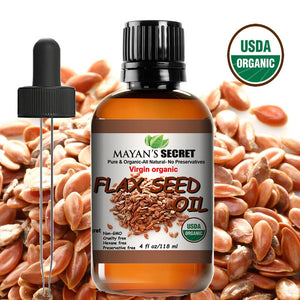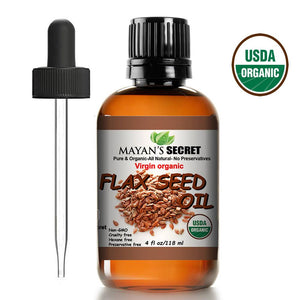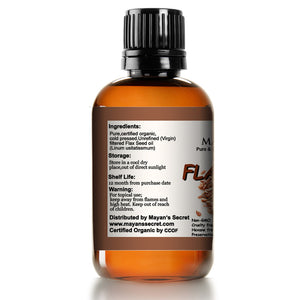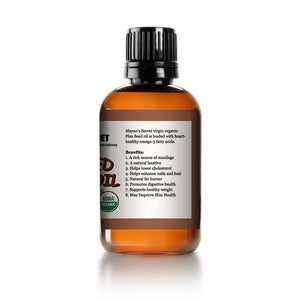Your Cart is Empty





Mayan's Secret offers quality products inspired by ancient traditions and natural ingredients, including oils, beauty items, and superfoods, promoting self-care and enhancing the senses.

Premium Quality Source: Mayan's Secret Flax Seed Oil is derived from carefully selected flax seeds, ensuring a high-quality and authentic product rich in essential fatty acids and nutrients.
Cold-Pressed Extraction: Our Flax Seed Oil is extracted using the cold-pressing method, which helps retain the natural integrity and beneficial properties of the seeds, resulting in a pure and unrefined oil.
Nutrient-Rich Composition: Mayan's Secret Flax Seed Oil boasts a rich profile of omega-3 fatty acids, lignans, and antioxidants, offering a nourishing addition to your diet that promotes overall well-being.

Nourish and Hydrate Skin - Flax Seed Oil can be used topically to moisturize and nourish the skin, promoting a healthy and radiant complexion.

Revitalize Hair and Scalp - Apply Flax Seed Oil to your hair and scalp for a revitalizing experience, helping to strengthen the hair and reduce dryness.

Enhance Natural Beauty - Flax Seed Oil offers natural beauty benefits, providing nourishment and support for healthy hair, skin, and overall well-being.
Revitalize Your Beauty Routine with Mayan's Secret Flax Seed Oil - Discover Radiant Skin and Luscious Hair!

Ingredients:
2 tablespoons Mayan's Secret Flax Seed Oil
1 tablespoon Argan Oil
5 drops Lavender Essential Oil
5 drops Rosemary Essential Oil
Instructions:
Mix all the ingredients in a glass dropper bottle. Apply a few drops to damp hair, focusing on the ends. Style as usual. This serum will help nourish and strengthen your hair, leaving it shiny and healthy.

Ingredients:
1 tablespoon Mayan's Secret Flax Seed Oil
1 tablespoon Honey
1 tablespoon Aloe Vera Gel
Instructions:
In a small bowl, mix the flax seed oil, honey, and aloe vera gel until well combined. Apply the mixture to your face and leave it on for 15-20 minutes. Rinse off with warm water. This soothing face mask will hydrate and calm your skin, giving it a radiant glow.

Ingredients:
1/2 cup Mayan's Secret Flax Seed Oil
1 cup Organic Sugar
10 drops Peppermint Essential Oil
5 drops Lemon Essential Oil
Instructions:
In a mixing bowl, combine the flax seed oil, organic sugar, peppermint essential oil, and lemon essential oil. Stir well until all the ingredients are evenly distributed. Gently massage the scrub onto damp skin in circular motions, focusing on dry areas. Rinse off with warm water. This revitalizing body scrub will exfoliate and moisturize your skin, leaving it smooth and rejuvenated.

Amber Glass Bottles and Glass Droppers: We prioritizes the quality of our oil by utilizing amber glass bottles and glass droppers, safeguarding it from light and external factors. This preserves the oil's potency that promotes best skincare.
Extended Shelf Life and Potency: We ensure the long-lasting effectiveness of our oil through our packaging that protects it from light-induced oxidation. It extends the shelf life and preserves the potency of the oil, allowing everyone to experience its lightweight, and non-greasy properties enriched with vitamins for an extended period.
Commitment to Packaging Excellence: Mayan's Secret's unwavering commitment to exceptional quality is demonstrated through our packaging. This choice not only preserves and protects our oil but also enhances the overall skincare experience, reflecting their dedication to providing natural, nourishing, and effective products.

✔️Premium Grade, Pure, Highest Quality
✔️Routinely Tested for Purity and Other Unique Qualities in Order to Ensure You Are Buying the Purest and best Available.
✔️Customer Happiness is our #1 Goal! !